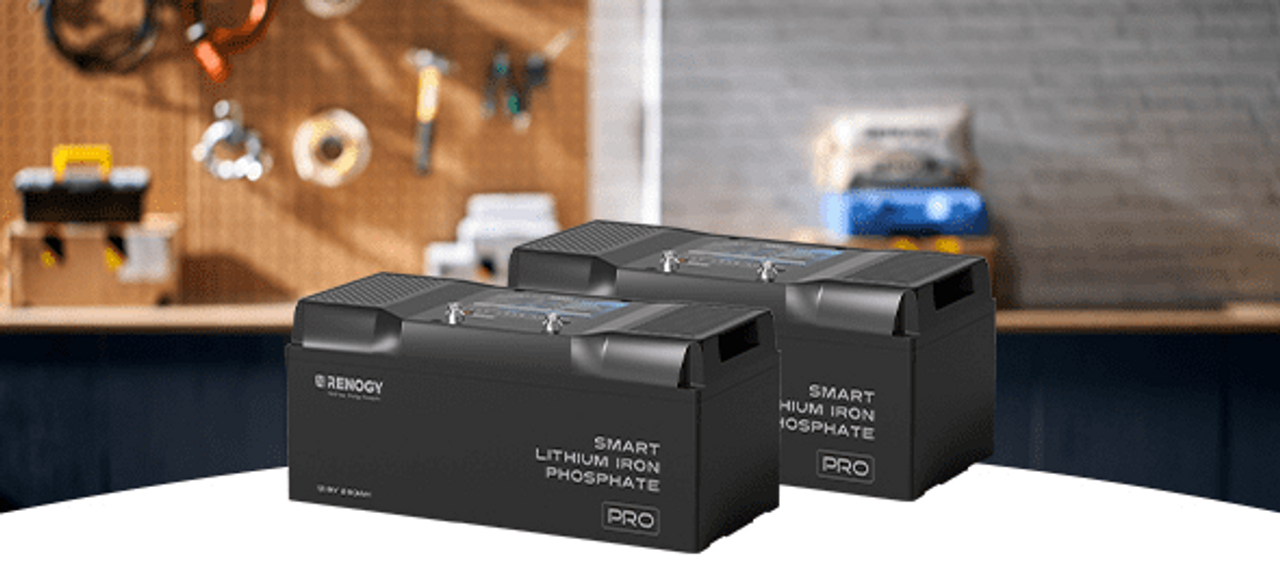A Comprehensive Guide to LiFePO4 Voltage Chart
Lithium Iron Phosphate (LiFePO4) batteries have revolutionized energy storage with their exceptional performance, longevity, and safety features. At the heart of understanding and optimizing these powerhouses lies the LiFePO4 voltage chart – a crucial tool for battery management and performance assessment. This comprehensive guide will demystify the LiFePO4 voltage chart, explaining how to interpret voltage levels, maximize battery life, and optimize your energy storage system's performance.
Basics about LiFePO4 Battery Voltage
Lithium Iron Phosphate batteries also called LiFePO4 are known for high safety standards, high-temperature resistance, high discharge rate, and longevity. High-capacity LiFePO4 batteries store power and run various appliances and devices across various settings. The voltage of Lithium-ion phosphate rechargeable batteries varies depending on the SOC. As the battery charges or discharges, the voltage increases. The higher the LiFePO4 battery voltage, the more increased capacity and energy stored.
Here are some basic definitions to enable you to understand LiFepo4 battery voltage better.
- Nominal Voltage- The battery delivers its best performance at the recommended level, 3.25V. This standard level is for monitoring the charging and discharging of the battery.
- Storage Voltage- This is the ideal voltage in which the battery must be stored if not in use for a prolonged time. Storage voltage ensures good battery health and reduces capacity loss.
- Fully Charged Voltage- It ranges at 3.65V and it is the maximum voltage for charging. Charging beyond this level causes irreparable battery damage.
- Discharge Voltage- Discharge optimal voltage is 2.5V. A user should never discharge under this level. Exceeding the discharge limit damages the battery.
- Deep Discharge- At this point, the voltage runs below the recommended level. Deep discharge renders the LiFePO4 batteries and may render them completely obsolete.
The LiFePO4 Voltage Chart: 12V, 24V, and 48V
The LiFePO4 voltage chart enables the users to understand the recommended charge levels for safe charging. Also, it acts as a reference point for gauging battery performance and identifying the state of charge for various batteries.
Here is a voltage chart illustrating the state of charge at various voltages.
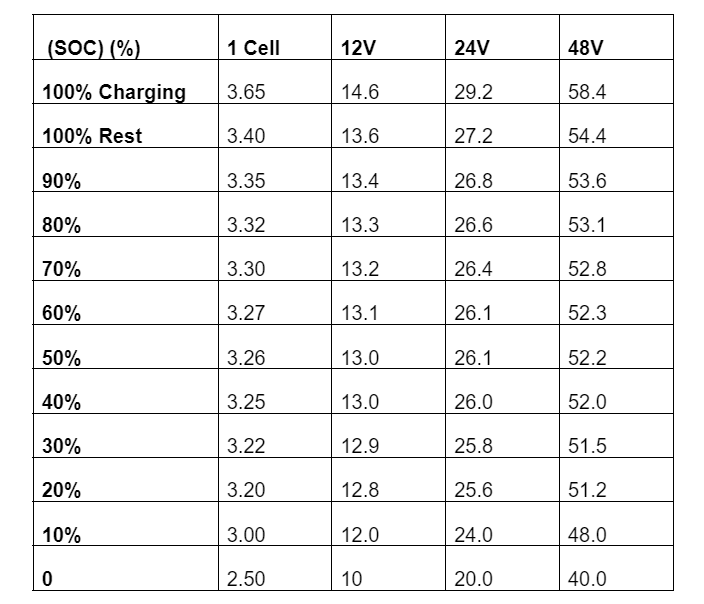
3.2V Battery Voltage Chart
Every lithium iron phosphate battery has a nominal voltage of 3.2V, with a charging voltage of 3.65V. The discharge cut-down voltage of LiFePO4 cells is 2.0V. Here is a 3.2V battery voltage chart.
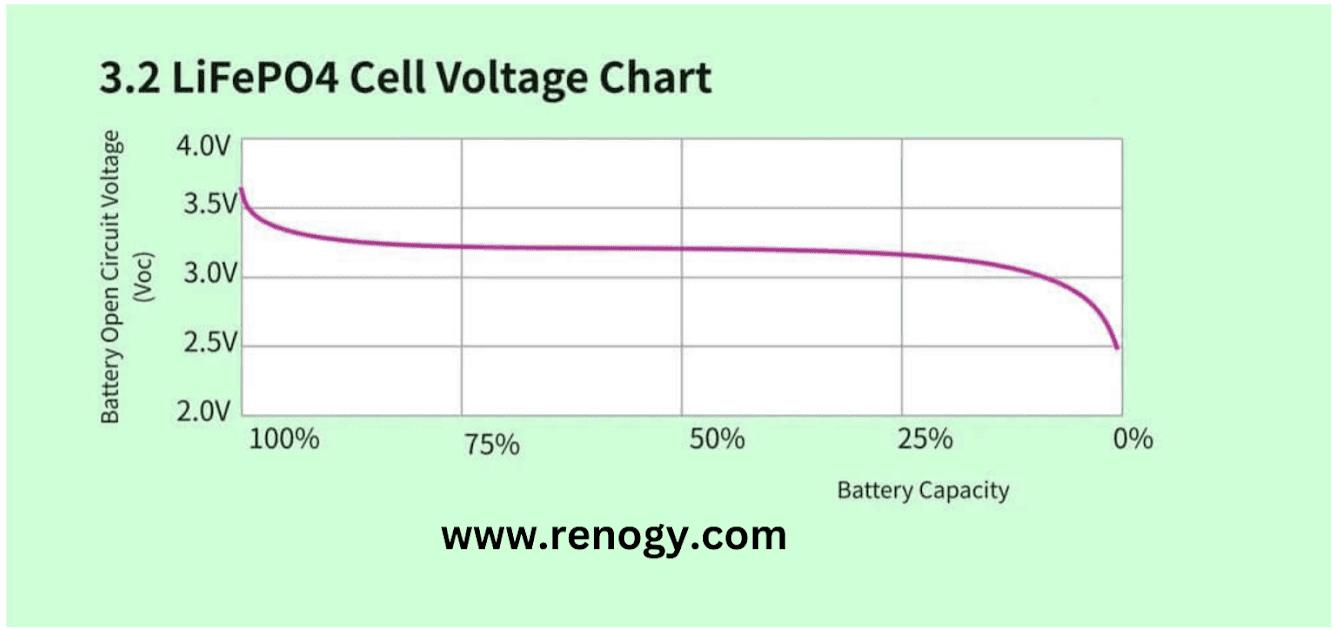
12V Battery Voltage Chart
Thanks to its enhanced safety features, the 12V is the ideal voltage for home solar systems. It has a voltage of 14.6V at a full charge and a discharge of 10V. Below is an illustration of the 12V battery voltage.
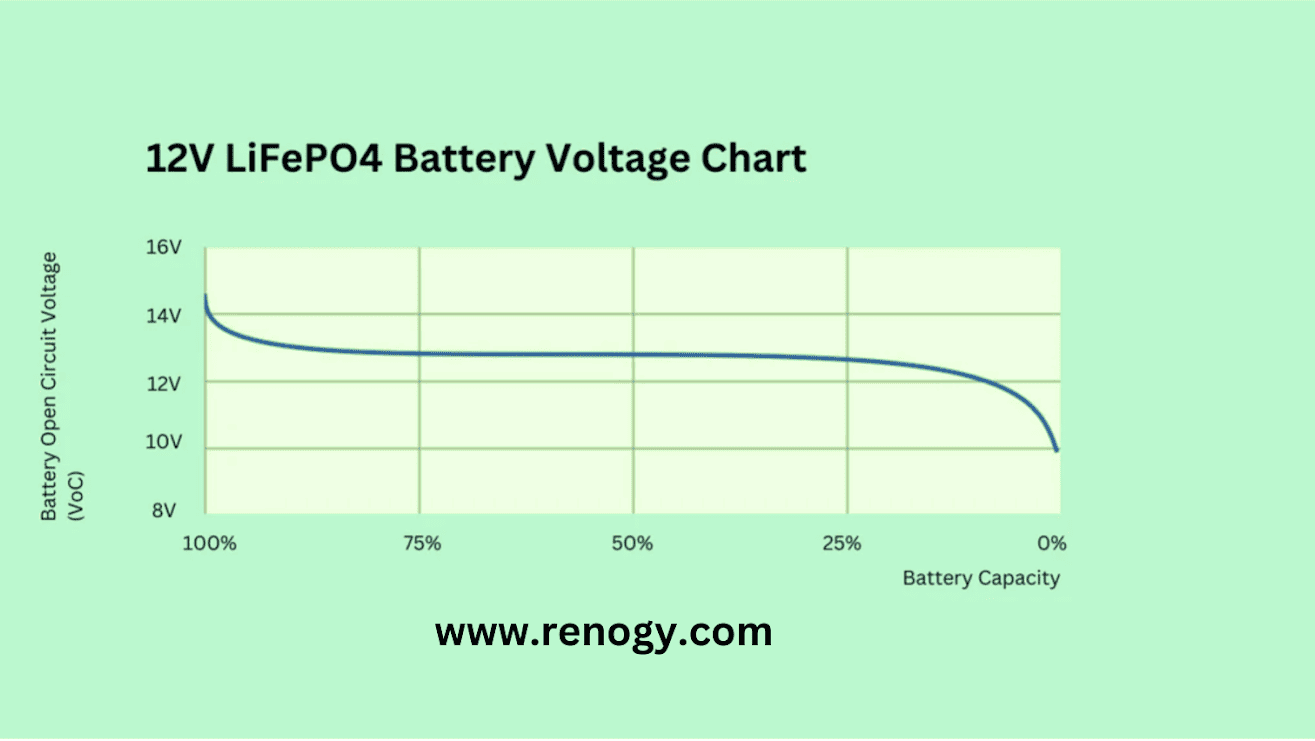
24V Battery Voltage Chart
24V LiFePO4 batteries completely charges at 29.2V and discharges at 20V. Check the chart illustration below.
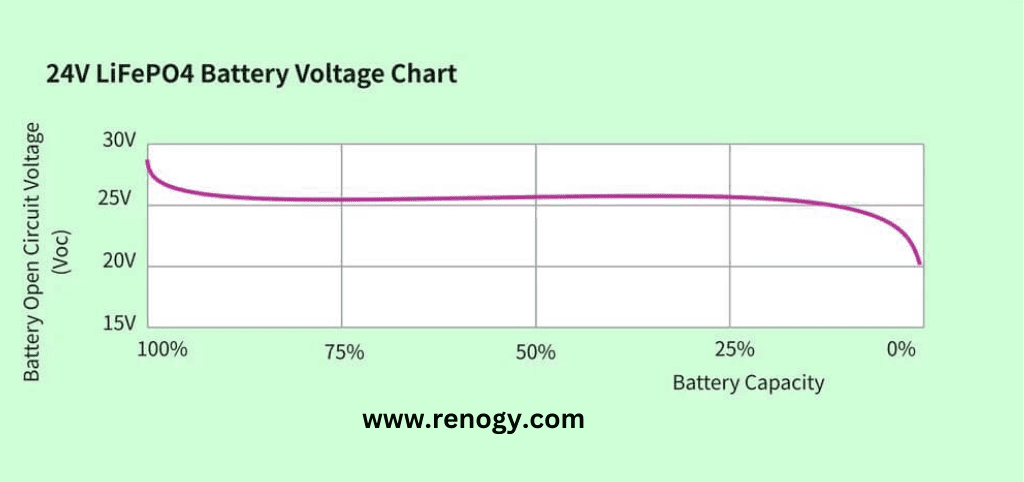
48V Battery Voltage Chart
48V LiFePO4 batteries are suitable for large solar power system installations. It keeps the amperage low and helps in saving on equipment and wiring costs.
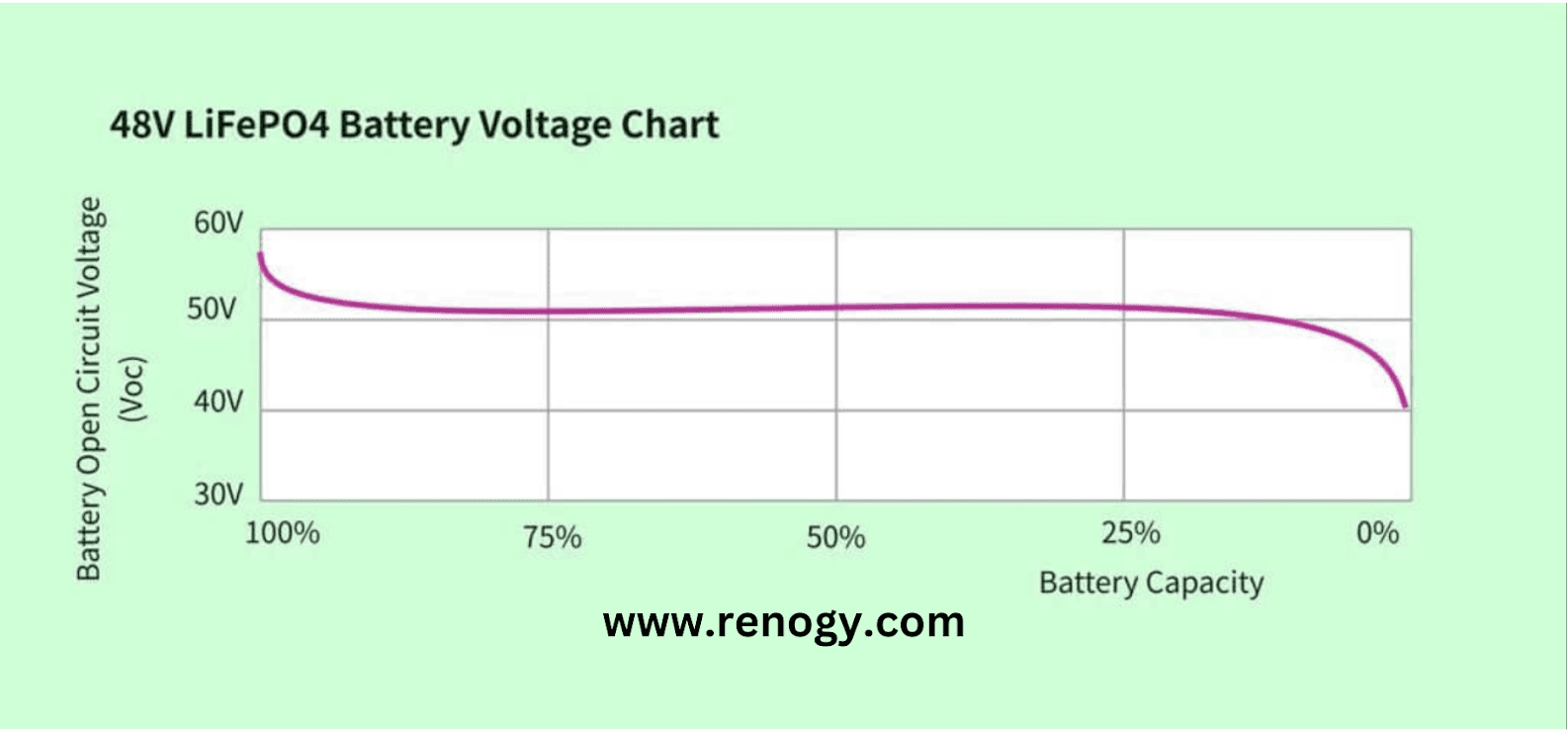
LiFePO4 Battery Charging Parameters
The recommended charging parameters ensure optimal battery performance, good health, and durability. Every user must observe these parameters during charging. Avoid overcharging or undercharging for efficient power storage and longer lifespan. The following is a LiFePO4 battery charging parameter chart.
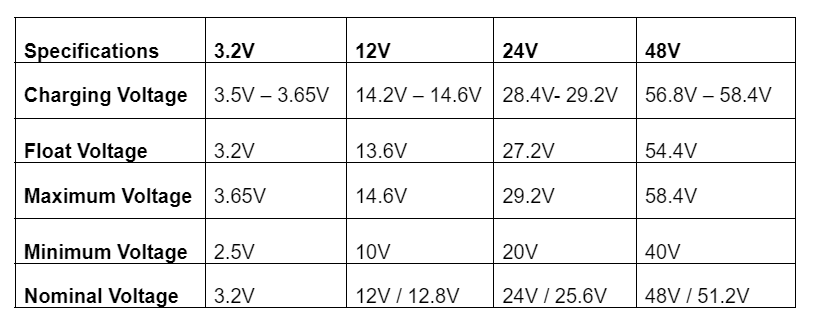
LiFePO4 Batteries Bulk, Float, and Equalize Voltages
LiFePO4 batteries have various voltage stages, namely: bulk, float, and equalize. During the bulk stage, the battery charges rapidly at a constant current up to a certain voltage. In the float stage, the battery maintains the voltage charge. This extends the battery's efficiency and extends its lifespan. The equalization stage balances the cells while ensuring uniform charging.

LiFePO4 Batteries: Charging and Discharging Processes
In simple terms, the cycles or the charge and discharge rates are the battery's charging patterns. These charging patterns are crucial for maintaining the health and durability of the battery. Therefore, you must observe proper and safe charging and discharging patterns. The state of charge indicates the capacity that can be discharged over the total battery capacity. The voltage increases when you charge the battery. The SOC of the battery is dependent on its charge.
Example: A 100Ah battery has a 30Ah capacity for discharging. Therefore, the SOC is 30%. If the battery charges to 100Ah and discharge 70Ah, then 30Ah remains.
Here is a lithium battery chart indicating the correlation between SOC and LiFePO4 voltage:
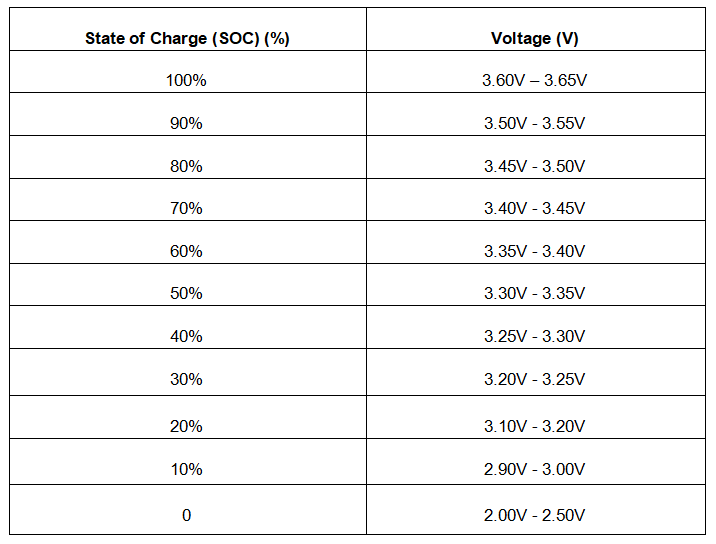
Does Voltage Affect LiFePO4 Battery Performance?
Yes. Voltage significantly affects various aspects of lithium iron phosphate batteries, including performance and durability. Proper knowledge of these effects will guide to proper utilization and maintenance of the battery for optimal performance.
- Capacity - The battery voltage and capacity are both proportionate. Meaning, that the voltage affects the capacity of the LiFePO4 batteries. An increase in battery voltage causes a capacity increase. Batteries with higher capacity and voltage are capable of storing a high amount of energy and charging your devices longer.
- Lifespan - LiFePO4 batteries with high voltage last longer than batteries with lower voltage. Batteries with higher voltages are capable of handling more cycles. Maintaining optimum voltage minimizes risks of thermal runaway and incomplete chemical reactions, which contributes to faster battery degradation.
- Charging - LiFePO4 battery voltage impacts its charging capabilities. Voltage-sensitive charging ensures battery safety and efficiency. Wrong voltage results in overheating or undercharging which ultimately affects the battery’s performance, health, and lifespan.
- Discharging - LiFePO4 battery voltage discharge can affect its performance. Discharging the battery below the prescribed voltage level causes permanent damage and shortens its lifespan.
- Efficiency - The LiFePO4 battery is proportional to its voltage. Therefore, a battery with a high voltage level supplies power efficiently.
How to Check LiFePO4 Battery Capacity
Keep your LiFePO4 battery performing optimally and for a long time by checking and monitoring it regularly. The following methods will enable you to measure the LiFePO4 battery capacity accurately.
- Use Multimeter - A multimeter is a specialized battery tester that ensures accurate voltage readings and battery capacity.
- Battery Monitor - This is a reliable battery testing method that provides detailed information on the battery capacity. The battery monitor evaluates battery specs such as the battery’s health, capacity, voltage, and energy discharged, and predicts the battery lifespan.
- Solar Charge Controller - The solar charge controller checks the LiFePO4 battery capacity. This method is useful for systems that have integrated solar systems.
- App Monitoring - Some batteries allow remote control and monitoring of LiFePO4 batteries. The App enables you to monitor the performance, and voltage, among other features using your smartphone.
Battery Capacity Calculation Formula: Capacity= Discharge Current (A) X Discharge Time (Hours)
Conclusion
Voltage chart is critical in determining the performance, energy density, capacity, and durability of Lithium-ion phosphate(LiFePo4) batteries. Remember to factor in SOC for accurate reading and interpretation of voltage. However, please abide by all safety precautions when dealing with all kinds of batteries and electrical connections.
FAQ
What is the most suitable LiFePO4 battery voltage?
The best voltage range is 13.2V to 13.2V. If you are not certain, always consult the voltage chart for accurate voltage. Ensure to maintain the voltage with this range for good health and longevity of LiFePO4 batteries.
How do I tell when my LiFePO4 battery is starting to malfunction?
Sure, your battery will not last a lifetime. But, it should give you good services for over ten years. However, if you notice any of these signs, it is an indication of a faulty battery.
- The battery takes abnormally longer to charge
- The battery does not charge at all
- It starts to swell up
- The devices power off while charging while there is a significant amount of charge in the battery.
What is the least damaging LiFePO4 battery voltage?
The minimum 12V LiFePO4 battery voltage damage is 10V. Discharging below the 10V minimum causes permanent and irreversible battery damage.

